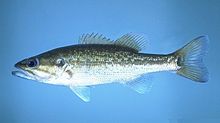Spotted bass
| Spotted bass | |
|---|---|

| |
| Scientific classification | |
| Domain: | Eukaryota |
| Kingdom: | Animalia |
| Phylum: | Chordata |
| Class: | Actinopterygii |
| Order: | Perciformes |
| Family: | Centrarchidae |
| Genus: | Micropterus |
| Species: | M. punctulatus
|
| Binomial name | |
| Micropterus punctulatus (Rafinesque,1819)
| |
| Synonyms[2] | |
|
Calliurus punctulatusRafinesque, 1819 | |
Thespotted bass(Micropterus punctulatus), also calledspotty,orspotsin various fishing communities, is aspeciesofNorth Americanfreshwater fishbelonging to the sunfishfamily(Centrarchidae) of theorderPerciformes.It is noted for the rows of dark spots below the lateral line, which give it its common name. One of theblack basses,it is native to theMississippi Riverbasinand across theGulf states,from centralTexasthrough theFlorida panhandle.Its native range extends into the westernMid-Atlantic statesand it has been introduced into westernNorth CarolinaandVirginia.It has also beenintroducedtosouthern Africa,where it has become established in some isolated waters as aninvasive species.
Spotted bass can reach an overall length of almost 64 cm (25 in), and can weigh up to 5.2 kg (11 lb). It can live to an age of at least seven years. Preferring cool and warm mountainstreamsandreservoirswith rocky bottoms, the spotted bass feeds oninsects,crustaceans,frogs,annelidworms and smaller fish. It is often mistaken for the similar and more commonlargemouth bass.A convenient way to distinguish between a largemouth and a spotted bass is by the size of the mouth. A spotted bass will resemble a largemouth bass in coloration but will have a smaller mouth.
In 2010, the scientific community officially recognized a separatesubspeciesof spotted bass, native to theTallapoosaandCoosa Riversand theirlakes.This species is commonly known as theAlabama spotted bass(M. henshalli) and known locally as the "Coosa spotted bass", not to be confused with theredeye Coosa bassfound innortheast Georgia.[3]The Alabama spotted bass is highly prized as agamefishand average size is much larger than the more common Kentucky spotted bass. The current record spotted bass, caught inPine Flat Lake,California,weighed 10.27 lb (4.66 kg).[4]
Etymology[edit]
Micropterusmeans small fin, andpunctulatusmeans dotted.[5]
Description[edit]

Manyanglerswho catch a spotted bass mistake it for alargemouth bassdue to the coloration, although there are subtle differences. The spotted bass, like allblack bassesexcept the largemouth, hasscaleson the base portion of the seconddorsal fin,its first and second dorsal fin are clearly connected, and itsupper jaw bonedoes not extend back to or beyond the rear edge of the eyes.
The spotted bass is also often confused with asmallmouth bass(or "smally" for short), but it lacks the vertical bars that are present on the sides of a smallmouth's body. The spotted bass also has small black spots below thelateral lineunlike either the large or smallmouth bass. Juveniles often resemble the young smallmouth bass in having a broad band of orange at the base of the tail, followed by a broad black band and white edge. The spotted bass is known tohybridizewith the smallmouth, which sometimes makes identification difficult. Spotted bass can be found in deeper water than smallmouth bass, at depths up to 100 ft (30 m).[6]
Distribution and habitat[edit]
Spotted bass seems to segregated by habitat type from closely related species such as the largemouth and smallmouth basses. They tend to be found in areas with morewater currentthan the largemouth, and usually inhabit areas that are too warm, turbid and sluggish for smallmouth bass. They usually occur aroundaquatic vegetation,submerged logs, and rock orriprapwalls in small to large flowing streams, rivers, and reservoirs. Spotted bass are distributed throughout theOhio Riverbasin as well as the central and lowerMississippi Riverbasin. The species may be found inGulf Coast statesfromTexaseast toFlorida.Spotted bass are native to portions ofEast Texas,particularly in theSabine,NechesandCypress Rivers.[7]
Diet[edit]
Spotted bass usually feed on small fishes,crayfishandaquatic insects.[5]The young begin withcopepodsand other smallcrustaceansand soon begin to eat insects. The spotted bass' diet falls in between the largemouth and smallmouth bass. It isn't nearly aspredatoryas the largemouth and only consumes about half the amount of the fish. Like all bass the spotted bass feeds by opening its mouth and creating a negative pressure thatsucks inthe prey.[8]
Reproduction and life cycle[edit]
The spotted bass can live approximately six years.[9]Spawningoccurs from April to May in habitat similar to that used by smallmouth. The males build their nest in gravel or other substrate, then entices a female to deposit hereggs.The males guard the eggs until they disperse. Several spotted and smallmouth bass hybrids have been collected recently in area reservoirs suggesting there is occasionally competition between the two species for spawning habitat.[10]
Importance to humans[edit]
The spotted bass is a populargame fishthat is fished regularly. In this context spotted bass is a goodfood fishfor human consumption.
Invasive species[edit]
The spotted bass was introduced to the Thee River,Olifants‐Doring Riversystem,Western Cape Province,South Africaas game fish before 2007, and is nowrated as an invasive species.The population was successfully eradicated in 2014, wheregillnetsandhand netswere used to remove the majority of the stock, while individuals were also caught byspearguns,seine netsand backpackelectrofishing.The spotted bass was held responsible for a decline in abundance of nativefiery redfin(Pseudobarbus phlegethonBarnard, 1938) andCape galaxias(Galaxias zebratusCastelnau, 1861).[11]
See also[edit]
References[edit]
- ^NatureServe (2013)."Micropterus punctulatus".IUCN Red List of Threatened Species.2013:e.T202565A18234277.doi:10.2305/IUCN.UK.2013-1.RLTS.T202565A18234277.en.Retrieved19 November2021.
- ^Froese, Rainer; Pauly, Daniel (eds.) (2019)."Micropterus punctulatus"inFishBase.December 2019 version.
- ^"Nomenclature of the Spotted Bass".Archived fromthe originalon 2012-06-14.
- ^"State Records for Spotted Bass".Archived fromthe originalon 2012-06-14.
- ^ab"Spotted Bass".Outdoor Alabama.2014-07-16.Retrieved2016-05-04.
- ^"Bass, spotted".Igfa.org.Retrieved2016-10-19.
- ^"Spotted Bass (Micropterus punctulatus)".Tpwd.texas.gov.Retrieved2016-05-04.
- ^"Spotted (Kentucky) Bass Freshwater Fish Information".Fish-identification.com.Retrieved2016-05-04.
- ^"Spotted Bass | MDC Discover Nature".Nature.mdc.mo.gov.Retrieved2016-05-04.
- ^"TWRA - Tennessee Wildlife Resources Agency - Spotted Bass".Tnfish.org.Retrieved2016-05-04.
- ^Walt, Johannes A.; Marr, Sean M.; Wheeler, Marius J.; Impson, N. Dean; Garrow, Craig; Weyl, Olaf L.F. (2019). "Successful mechanical eradication of spotted bass (Micropterus punctulatus (Rafinesque, 1819)) from a South African river".Aquatic Conservation: Marine and Freshwater Ecosystems.29(2): 303–311.doi:10.1002/aqc.3035.hdl:10019.1/112516.
External links[edit]
- Rohde, F. C., et al.Freshwater Fishes of the Carolinas, Virginia, Maryland, and Delaware.Chapel Hill: University of North Carolina Press, 1994,ISBN0807821306

